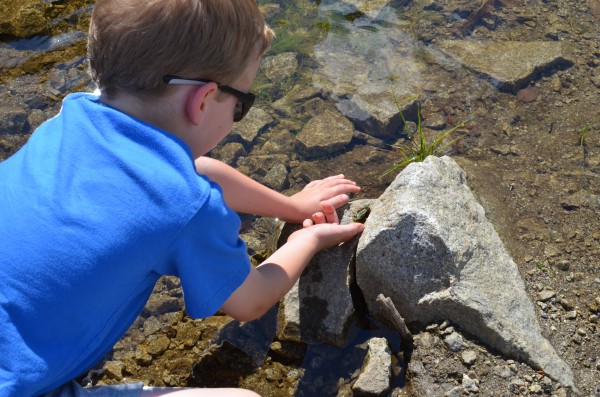Last Child in the Woods ~ Changes for the Future
I’m here with more thoughts on the book Last Child in the Woods by Richard Louv, joining in Nicole’s book study. Be sure to visit her at Journey to Excellence for her thoughts on these chapters and the big changes her family is making.

Chapters 18 through 20 in the book discuss ushering in the “fourth frontier” and reconnecting not just ourselves but our culture with nature. These chapters have very big, far-reaching goals that really involve a restructuring of how people live. The author’s point is that we can connect our kids with nature right now, but we need to make changes to our culture or the child-nature gap will continue to widen. I agree, but changes in population distribution sounds too orchestrated to me. I enjoy living in a rural area. If we were moving I would be interested in towns with a big connection to nature. But can you force those interests on the population as a whole?
I’ll admit this: he loses me a bit in these conversations. I tend to think small and change what I am in control of, versus getting involved in larger organizations. I pulled my kids out of school instead of working to change the school system. I was very excited to read the ideas for reconnecting myself and my children with nature that are within my immediate control–things I can implement on my own right now. But when the author talks of sweeping changes in the structure of towns and cities and businesses I feel more overwhelmed than able to help. Clearly there are movers and shakers who get involved in politics and organizations that make sweeping changes, and I’m grateful for them and benefit from the work that they do…but I’m not one of them.
In the discussions of cities he talks of making nature corridors, not just isolated parks that don’t look natural at all. The discussion of allowing movement and genetic diversity did hit home for us: we’ve been studying monarch butterflies and their amazing migration. They need milkweed plants as they migrate north from Mexico in the fall. If they don’t have milkweed plants to lay their eggs on in the southeast, we won’t have monarch butterflies in the summer in the northeast. My plan of action is growing my own milkweed patch, doing my small part. But I do hope the movers and shakers, like the Monarch Watch organization, are successful in protecting these amazing creatures.
Another small part I have been learning about for a while now as a gardener is using native plants that are less resource intensive. I live in a manicured neighborhood and am one of the very few that doesn’t spray my lawn with chemicals. It shows–my lawn is probably 50% clover and dandelions and other “weeds” BUT I haven’t suffered from the grub damage (grubs eat grass roots, not weed roots) of my neighbors with perfect lawns. I also have one of the greenest lawns right now because my weeds are surviving the drought much better than the grass of my neighbors. The reason I don’t spray: my kids and dog can play on it anytime without fear of chemical exposure.
In short, these chapters had interesting ideas, but didn’t give me ideas for implementation in my daily life. There are just three chapters left in the book. Join us for the last installment in this book study later this week or early next week.
 Hi, I'm Heidi and I homeschool my two sweet kids. I want them to know that learning is an exciting lifelong adventure! We love great books, unit studies, notebooking, lapbooking, and hands-on learning.
Hi, I'm Heidi and I homeschool my two sweet kids. I want them to know that learning is an exciting lifelong adventure! We love great books, unit studies, notebooking, lapbooking, and hands-on learning.



